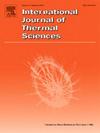不同几何参数波纹管中氧化铁/水纳米流体热液性能及不可逆性产率研究
IF 4.9
2区 工程技术
Q1 ENGINEERING, MECHANICAL
International Journal of Thermal Sciences
Pub Date : 2025-04-30
DOI:10.1016/j.ijthermalsci.2025.109964
引用次数: 0
摘要
本文研究了波纹汇聚管(CCPs)中氧化亚铁(Fe3O4)/水纳米流体在湍流状态下的热液性能和不可逆性产率。在Ansys Fluent中使用离散相和k−ω湍流模型对氧化铁(Fe3O4)/水纳米流体进行建模。考察了各因素对泊泽维尔数(fRe)、平均努塞尔数(Nu)、性能评价标准(PEC)和不可逆产率的影响。这些因素包括波纹轮廓(矩形、梯形和球形)、雷诺数(5.0×103≤Re≤3.0×104)、波纹归一化幅度(0.025≤eD≤0.035)、波纹归一化宽度(0.2≤wD≤0.4)、收敛直径比(1.0≤DR≤2.0)和纳米颗粒浓度(0.0%≤VR≤2.0%)。研究结果表明,尽管以增加的fRe为代价,但CCPs中的Nu高于光滑管。例如,在Re=104, VR=1%,DR=2.0,eD=0.025, wd =0.4时,矩形、梯形、球形ccp和作为参考管(RP)的光滑直管的Nu和fRe分别为{156.96,153.34,137.00,103.35}和{13938.44,11335.35,7537.07,551.71}。此外,研究发现,与RP相比,在改进的管道中,由于温度梯度⟨Sth本文章由计算机程序翻译,如有差异,请以英文原文为准。
Investigation of hydrothermal performance and irreversibility production rate of ferrosoferric oxide/water nanofluid in corrugated-converging pipes with varying geometry parameters
In this study, hydrothermal performance and irreversibility production rate in ferrosoferric oxide (Fe3O4)/water nanofluid flowing in corrugated-converging pipes (CCPs) in turbulent flow regime have been examined. The ferrosoferric oxide (Fe3O4)/water nanofluid is modeled using discrete phase and turbulent models in Ansys Fluent. The impact of various factors on the Poiseuille number , average Nusselt number , performance evaluation criterion , and irreversibility production rate are thoroughly examined. These factors include corrugation profiles (rectangular, trapezoidal, and spherical), Reynolds number , normalized amplitude of corrugation (, normalized width of corrugation (, convergence diameter ratio (1.0 ≤ DR ≤ 2.0), and nanoparticles concentration (0.0 % ≤ VR ≤ 2.0 %). The findings revealed that the in CCPs is higher than that of smooth pipes, albeit at the expense of increased . For instance, at , , the values of and for rectangular, trapezoidal, and spherical CCPs and smooth straight pipe, which serves as the reference pipe (RP), are {156.96, 153.34, 137.00, and 103.35} and {13938.44, 11335.35, 7537.07, and 551.71}, respectively. In addition, it was found that, when compared to RP, the average volumetric entropy production rate due to the temperature gradient in modified pipes was lower. Furthermore, an increase in certain geometric parameters (DR and ) increased , , and the viscous volume-average entropy production rate . However, the opposite was observed for . Thus, from an energy-saving perspective, CCPs can be suggested as a promising heat transfer enhancement method, especially the trapezoidal CCP.
求助全文
通过发布文献求助,成功后即可免费获取论文全文。
去求助
来源期刊

International Journal of Thermal Sciences
工程技术-工程:机械
CiteScore
8.10
自引率
11.10%
发文量
531
审稿时长
55 days
期刊介绍:
The International Journal of Thermal Sciences is a journal devoted to the publication of fundamental studies on the physics of transfer processes in general, with an emphasis on thermal aspects and also applied research on various processes, energy systems and the environment. Articles are published in English and French, and are subject to peer review.
The fundamental subjects considered within the scope of the journal are:
* Heat and relevant mass transfer at all scales (nano, micro and macro) and in all types of material (heterogeneous, composites, biological,...) and fluid flow
* Forced, natural or mixed convection in reactive or non-reactive media
* Single or multi–phase fluid flow with or without phase change
* Near–and far–field radiative heat transfer
* Combined modes of heat transfer in complex systems (for example, plasmas, biological, geological,...)
* Multiscale modelling
The applied research topics include:
* Heat exchangers, heat pipes, cooling processes
* Transport phenomena taking place in industrial processes (chemical, food and agricultural, metallurgical, space and aeronautical, automobile industries)
* Nano–and micro–technology for energy, space, biosystems and devices
* Heat transport analysis in advanced systems
* Impact of energy–related processes on environment, and emerging energy systems
The study of thermophysical properties of materials and fluids, thermal measurement techniques, inverse methods, and the developments of experimental methods are within the scope of the International Journal of Thermal Sciences which also covers the modelling, and numerical methods applied to thermal transfer.
 求助内容:
求助内容: 应助结果提醒方式:
应助结果提醒方式:


